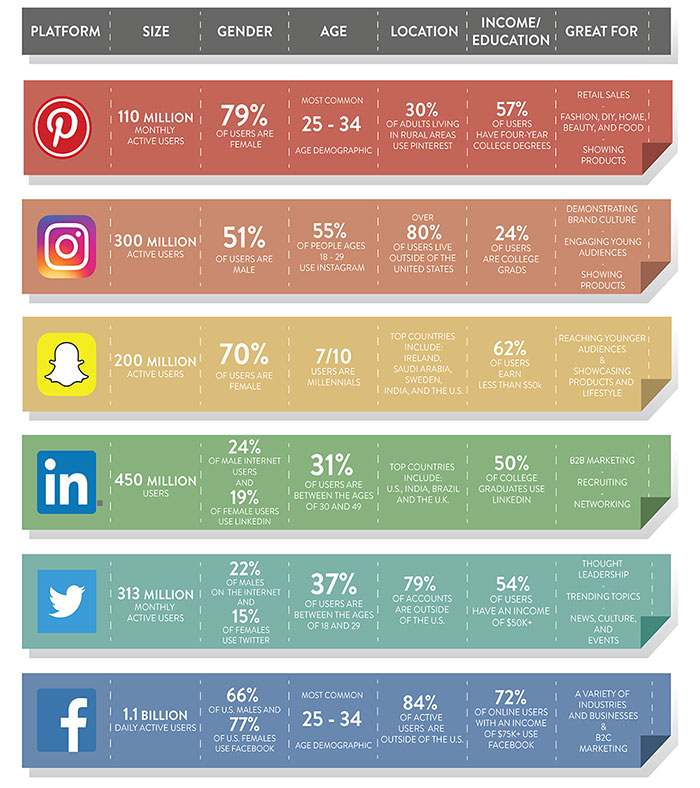There are some big benefits to using social media for your business and in this article I am going to take you through the key steps to get you started. But first of all, here are a few reasons why you should consider using social media for your business.

Benefits of Using Social Media for Your Business
Potential Audience Size
The amount of active users across the different social media platforms is staggering, just look at the numbers below which come courtesy of Statista:
- Facebook = 2.7 billion monthly users
- Youtube = 2.2 billion monthly users
- Instagram = 1.2 billion monthly users
These figures are increasing every year which shows that there is still plenty of growth left in the market and there are dozens of different platforms which cater for slightly different audiences.
Build Brand Awareness
Posting on social media allows you to drip-feed content to your audience on a regular basis which helps to keep your brand in your customers’ consciousness so that when they are ready to make a purchase, they are more likely to think of you.
Engage Directly With Your Customers
Social media platforms give you the opportunity to have direct conversions with your customers and start developing relationships which can transform your audience into loyal fans.
Drive Traffic to Your Website
Social media content is perfect to create a desire for your products and/or services and then direct people to your website to make a purchase.
Targeted Demographics
With social media advertising (which we will discuss later) you can be very specific about who your adverts get shown to,which makes it a very cost effective marketing tool.
How to Use Social Media for Your Business Step 1: Set Your Goals
When undertaking any kind of marketing activity it’s always a good idea to have a very clear set of goals defined and documented because this will determine the rest of your strategy. Here are a few ideas of different social media goals you can focus on.
- Increase brand awareness
- Drive website traffic
- Generate new leads
- Grow revenue
- Boost brand engagement
- Build a community
Try to make your goals SMART where possible which stands for: Specific, Measurable, Achievable, Relevant and Time-based. One of the great things about social media is that everything is easy to measure. For example, brand awareness can be measured by the amount of followers you have.
How to Use Social Media for Your Business Step 2: Identify Your Target Audience
This is an important activity even if you are not using social media. Understanding the target audience of your brand is critical for determining the type of content to produce and which platforms to actively manage. Here are some of the demographics to think about when it comes to you target audience:
- Age
- Gender
- Income
- Hobbies and interests
- Location
How to Use Social Media for Your Business Step 3: Pick Your Platforms
There are dozens of different social media platforms to choose from and each of them have a slightly different user base so it’s important to pick the right ones which are going to match your target customers. Here is a great infographic to demonstrate some of the key differences between the most popular platforms (Source: Socialfactor.com):

I would also recommend picking a maximum of three platforms to keep your workload at a manageable level unless you have a team of people at your disposal.
How to Use Social Media for Your Business Step 4: Plan Your Content
Consistency is very important when it comes to your content on social media and this requires planning in advance with regards to what you are going to be posting each week. You’ll also need to decide how often you’ll be posting which could be once a week, three times a week or even daily.
A simple way to plan your content is to create a spreadsheet where you can keep all your ideas, write your copy and schedule the posts for specific days and times. This means that you can plan for weeks or months in advance and you’ll always be prepared.
If you want to take your planning to the next level there are plenty of social media management tools like Hootsuite and Later which are purposely designed to make it easier for you to schedule your content and they even post automatically on your chosen platforms.
How to Use Social Media for Your Business Step 5: Use Paid Adverts
Growing your audience organically can take a long time so it’s definitely worth considering using paid adverts. This kind of marketing can be very targeted so your adverts only get shown to your ideal customers and it’s very cost effective too. For only £10 spent on Facebook you can get your advert shown to over 2,000 people which could result in around 50 clicks through to your website which is only 20p per click. The exact results that you’ll achieve will depend on many factors, but this should give you a good idea and help you budget for your own campaigns.
How to Use Social Media for Your Business Step 6: Hire the Experts
Whilst it is definitely possible to manage the social media accounts for your business, you’ll probably see faster growth and more engagement by employing the services from someone who is skilled and experienced in this field.
At KIKLAB we have been managing the social media accounts of our clients for years and offer a range of services including:
- Optimising your accounts for business use
- Producing and posting new content
- Growing your audience
- Interacting with your customers
- Running promotional adverts
- Monitoring your performance
If you’d like to find out more about our social media services, just click the link.
Summary
Social media can be a very useful marketing tool for your business to build brand awareness, engage with your customers and drive traffic to your website. We have identified 6 key steps to help you get the most out of your social media accounts as follows:
- Step 1: Set your goals
- Step 2: Identify your target audience
- Step 3: Pick your platforms
- Step 4: Plan your content
- Step 5: Use paid adverts
- Step 6: Hire the experts
Social media is just one element of digital marketing you can use to grow your business. Alongside this we would also recommend investing your time and effort into other strategies like Search Engine Optimisation (SEO) and Pay Per Click (PPC) advertising on google. If you would like to find out more about either of these digital marketing approaches just click on the link.





